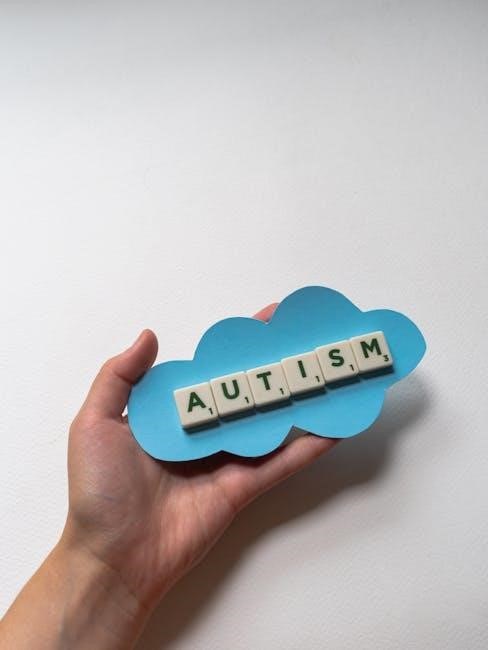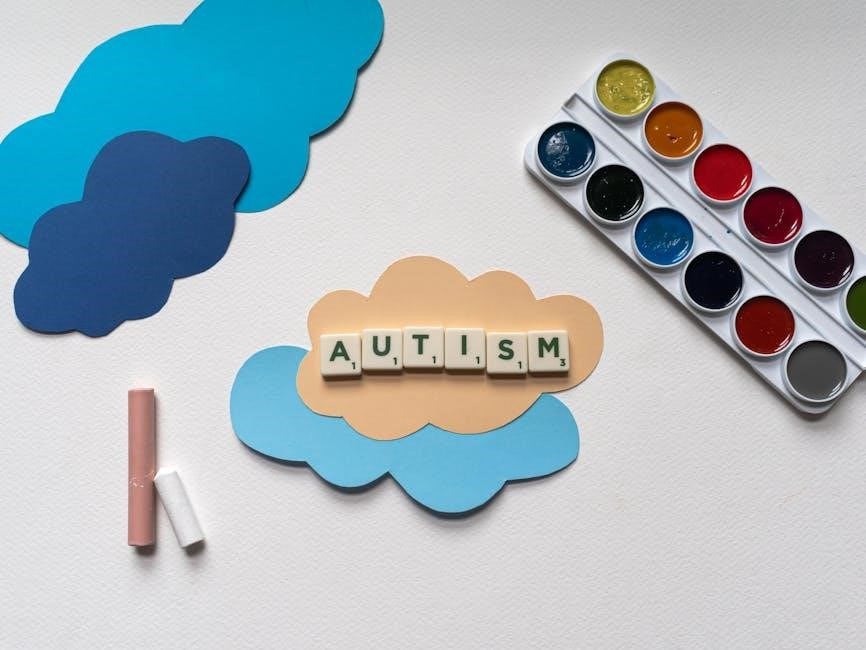
Occupational therapy (OT) interventions for autism focus on enhancing sensory processing, motor skills, and daily functioning․ These evidence-based strategies, including sensory integration and play-based approaches, support individuals in achieving independence and improving overall quality of life through tailored and adaptive methods․

Sensory Integration
Sensory integration focuses on improving how individuals process sensory information․ Occupational therapists use structured activities to enhance the brain’s ability to integrate sensory inputs, reducing overwhelming responses and fostering better engagement in daily activities through organized sensory experiences․
Sensory Integration Therapy

Sensory integration therapy is a cornerstone of occupational therapy for autism, addressing sensory processing challenges․ Therapists design activities tailored to each individual’s needs, using tools like swings, weighted blankets, and tactile exercises to help regulate sensory responses and improve nervous system function․ This approach encourages the brain to process sensory information more effectively, reducing sensory overload and enhancing participation in daily activities․ By fostering a balanced sensory system, individuals can better engage in their environment and perform tasks with greater ease and confidence․ Regular sessions often lead to noticeable improvements in behavior and overall well-being, making sensory integration therapy a vital component of autism intervention strategies․
Sensory-Based Strategies
Sensory-based strategies are essential in occupational therapy for autism, providing practical techniques to manage sensory challenges․ These strategies often involve incorporating sensory-friendly tools and activities into daily routines, such as using fidget toys for focus or applying deep pressure for self-regulation․ The goal is to create environments that are calming and supportive, reducing sensory overload and promoting emotional stability․ Therapists also educate families and caregivers on how to implement these strategies at home, ensuring consistency and continuity․ By addressing each individual’s unique sensory needs, these interventions help enhance participation in daily activities and improve overall quality of life․ Sensory-based strategies are often combined with other therapies for a comprehensive approach to autism support, making them a key element in fostering independence and well-being for individuals with autism․

Motor Skills Development
Motor skills development in occupational therapy for autism focuses on improving fine and gross motor abilities․ Activities like using toothpicks for fine motor precision and obstacle courses for gross motor coordination help enhance dexterity, balance, and overall physical functioning, fostering independence in daily tasks․
Fine Motor Skills
Fine motor skills are essential for tasks like writing, buttoning shirts, and using utensils․ Occupational therapy for autism often includes activities such as puzzles, drawing, and picking up small objects like toothpicks to enhance hand-eye coordination and dexterity․ These exercises help improve precision and control, enabling individuals to perform daily activities with greater ease and independence․ Adaptive tools and structured play further support the development of these skills, making everyday tasks more manageable and fostering confidence in the individual’s ability to interact with their environment effectively․
Gross Motor Skills
Gross motor skills, such as running, jumping, and balance, are often targeted in occupational therapy for autism․ Activities like obstacle courses, ball games, and structured physical exercises help improve coordination and overall physical abilities․ These interventions are designed to enhance the child’s ability to engage in age-appropriate physical activities, fostering confidence and reducing challenges in social and play settings․ By incorporating sensory integration techniques, such as swinging or using bean bags, therapists can address any sensory processing difficulties that may impact motor performance․ Regular practice and repetition of these activities, tailored to the individual’s needs, can lead to significant improvements in posture, balance, and movement patterns․ Occupational therapists also emphasize the importance of a structured environment to help children with autism feel secure and motivated during these exercises․ The goal is to equip them with the physical skills necessary to participate fully in daily activities, recreational play, and social interactions, thereby enhancing their overall quality of life and independence․

Social Skills Development
Occupational therapy addresses social skills development by enhancing interaction, communication, and relationship-building abilities․ Techniques like role-playing, peer interaction, and structured group activities help individuals with autism navigate social situations confidently, fostering meaningful connections and improving overall social competence․

Play-Based Interventions
Play-based interventions are a cornerstone of occupational therapy for autism, utilizing playful activities to foster skill development and emotional growth․ These interventions create a natural, engaging environment where children can practice social interactions, explore sensory experiences, and develop problem-solving abilities․ By incorporating elements like imaginative play, role-playing, and interactive games, therapists help individuals build confidence and self-esteem․ Play-based approaches also encourage creativity, adaptability, and collaboration, which are essential for navigating complex social situations․ Moreover, these interventions often involve the use of toys, art, and imaginative tools, allowing children to express themselves freely and process emotions in a healthy manner․ The therapeutic benefits of play extend beyond mere entertainment, providing a structured yet flexible framework for addressing diverse developmental needs․ As a result, play-based interventions not only enhance cognitive and motor skills but also lay the groundwork for long-term social and emotional well-being in individuals with autism․
Social Participation Strategies
Social participation strategies in occupational therapy for autism are designed to enhance individuals’ abilities to engage meaningfully in social activities and community life․ These strategies focus on developing communication skills, understanding social cues, and fostering meaningful relationships․ Activities such as group games, role-playing, and community outings are often used to provide practical opportunities for social interaction․ Occupational therapists also incorporate structured programs, like social skills groups, to teach specific behaviors such as initiating conversations, active listening, and cooperation with peers․ Additionally, strategies may involve collaboration with families and caregivers to create supportive environments that encourage social participation at home and in public settings․ The goal is to help individuals with autism feel more comfortable and confident in social situations, thereby improving their overall quality of life and integration into society․ By addressing barriers to social engagement, these strategies aim to promote long-term independence and fulfillment in both personal and communal contexts․

Mental Health and Wellness
Occupational therapy addresses mental health by reducing anxiety and stress in individuals with autism․ Strategies include sensory-based approaches to regulate emotions and improve resilience․ OT fosters emotional well-being, enabling individuals to cope with challenges and maintain a positive mental state for overall wellness․
Mental Health Treatment
Mental health treatment in occupational therapy for autism focuses on addressing emotional and psychological challenges․ Therapists use evidence-based interventions to help individuals manage anxiety, stress, and other mental health issues․ These interventions often incorporate sensory integration techniques, mindfulness activities, and emotional regulation strategies․ The goal is to enhance the individual’s ability to cope with daily stressors and improve their overall mental well-being․ By addressing these challenges, occupational therapy plays a crucial role in supporting the mental health and emotional resilience of individuals with autism, enabling them to lead more fulfilling lives․

Daily Living Skills
Occupational therapy plays a vital role in helping individuals with autism develop essential daily living skills․ These skills include self-care activities such as dressing, grooming, and feeding, as well as functional tasks like using utensils or completing household chores․ Through structured activities and adaptive strategies, OT fosters independence and confidence, enabling individuals to participate fully in their daily routines and enhance their overall quality of life․
Self-Care Activities
Self-care activities are a cornerstone of occupational therapy interventions for individuals with autism, aiming to promote independence in daily routines․ These activities include personal hygiene practices such as bathing, brushing teeth, and dressing, which are often challenging due to sensory sensitivities or motor skill deficits․ Occupational therapists employ structured approaches, incorporating sensory integration techniques and adaptive tools, to make these tasks more manageable․ For instance, using visual schedules or sensory-friendly products can help individuals with autism navigate self-care routines with greater ease․ Additionally, play-based interventions are utilized to teach and reinforce these skills in a engaging and non-threatening manner․ The goal is to empower individuals to perform self-care tasks confidently and independently, thereby enhancing their overall quality of life and integration into societal norms․ By addressing these fundamental needs, occupational therapy not only improves physical well-being but also fosters emotional resilience and self-esteem, which are critical for long-term success․

Technology and Telehealth Interventions
Technology and telehealth interventions are revolutionizing occupational therapy for autism․ Tools like video modeling and virtual reality enhance engagement and accessibility․ Telehealth platforms enable remote delivery, reaching more individuals and improving functional skills through innovative and interactive methods effectively․
Telehealth Effectiveness
Telehealth has proven to be an effective delivery method for occupational therapy interventions in autism care․ It offers convenience, accessibility, and consistency, particularly for individuals in remote areas or with limited mobility․ Research indicates that telehealth interventions, including video-based sessions and digital tools, can improve functional skills, sensory processing, and social participation․ These platforms allow therapists to engage children in play-based activities remotely, using virtual environments to mimic in-person interactions․ Parents and caregivers can also receive training and support through telehealth, enabling them to implement therapeutic strategies at home․ The use of technology-enhanced visual supports and video modeling within telehealth sessions has been shown to increase independence in daily living tasks․ Furthermore, telehealth reduces barriers such as long wait times and transportation challenges, making occupational therapy more equitable․ Studies highlight high satisfaction rates among families using telehealth services, emphasizing its potential as a sustainable and effective approach for autism care․ Overall, telehealth is transforming the way occupational therapy is delivered, ensuring that individuals with autism can access essential interventions without compromising on quality or outcomes․

Early Intervention
Early occupational therapy intervention for autism is crucial, addressing sensory processing, motor skills, and social-behavioral performance․ It supports long-term developmental goals, enhancing independence and adaptive abilities through structured, adaptive strategies tailored to each child’s needs․
Impact of Early OT Intervention
Early occupational therapy (OT) intervention for autism significantly improves developmental outcomes, enhancing sensory processing and motor skills․ It fosters independence, adaptive behaviors, and social participation, reducing challenges in daily life․ Structured, adaptive strategies tailored to individual needs promote long-term benefits and improved quality of life․

